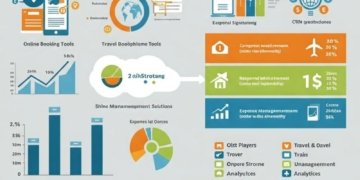The Data Historian Market is projected to grow from US$ 1.52 billion in 2022 to US$ 2.67 billion by 2032, with a CAGR of 5.8% over the decade. Data historian solutions, which account for around 14% of the global data visualization market, are essential for managing large datasets by capturing real-time data with accurate timestamps. These solutions provide critical insights for industries like process manufacturing, offering capabilities for asset performance management and production tracking.
𝐑𝐞𝐪𝐮𝐞𝐬𝐭 𝐟𝐨𝐫 𝐒𝐚𝐦𝐩𝐥𝐞: https://www.persistencemarketresearch.com/samples/24847
Key innovations, such as plant data historian software and hyper historian tools, are expected to drive growth, as companies seek more efficient ways to integrate, store, and visualize data. The market is also seeing increased adoption in industrial sectors, where these solutions help improve operational efficiency, profitability, and competitiveness by enabling advanced analytics and real-time decision-making.
𝐓𝐡𝐞 𝐑𝐢𝐬𝐞 𝐨𝐟 𝐃𝐚𝐭𝐚 𝐇𝐢𝐬𝐭𝐨𝐫𝐢𝐚𝐧𝐬 𝐢𝐧 𝐭𝐡𝐞 𝐔.𝐒. 𝐌𝐚𝐫𝐤𝐞𝐭
Data historians are specialized software applications designed to collect, store, and retrieve time-series data, typically from industrial systems, operations, and processes. The role of data historians has become vital in sectors such as manufacturing, energy, healthcare, and utilities, where historical data is essential for monitoring, analyzing, and optimizing operations.
In the U.S., the data historian market is expanding rapidly due to the need for industries to handle the massive influx of data generated by IoT devices, sensors, and automated systems. Real-time access to this data allows companies to make informed decisions, improve predictive maintenance, and enhance production performance.
𝐌𝐚𝐫𝐤𝐞𝐭 𝐃𝐲𝐧𝐚𝐦𝐢𝐜𝐬 𝐃𝐫𝐢𝐯𝐢𝐧𝐠 𝐭𝐡𝐞 𝐔.𝐒. 𝐃𝐚𝐭𝐚 𝐇𝐢𝐬𝐭𝐨𝐫𝐢𝐚𝐧 𝐆𝐫𝐨𝐰𝐭𝐡
Several factors are contributing to the accelerated growth of the U.S. data historian market, positioning it for significant expansion over the next decade.
1. Increased Adoption of Industrial IoT (IIoT): The integration of IoT devices into industrial processes is revolutionizing industries by generating vast amounts of real-time data. Data historians help store, retrieve, and analyze this time-series data, making it an indispensable tool for companies leveraging IIoT to enhance efficiency and decision-making.
2. Automation and Digitalization: The ongoing trend of automation and digital transformation across industries is fueling the demand for sophisticated data management tools, including data historians. Automated systems require continuous monitoring, and data historians play a crucial role in aggregating and storing critical historical data for improved control and management.
3. Regulatory Compliance and Reporting Requirements: In industries such as energy, manufacturing, and healthcare, maintaining accurate historical records is not just a matter of operational efficiency but also compliance with regulatory standards. Data historians ensure that companies can easily access historical data for audits, reports, and regulatory compliance.
4. Increased Focus on Predictive Maintenance: Predictive maintenance is becoming a core focus in industries with heavy machinery, such as manufacturing and energy. Data historians support predictive maintenance models by providing essential historical data to identify trends, predict failures, and optimize machine performance.
𝐔.𝐒. 𝐃𝐚𝐭𝐚 𝐇𝐢𝐬𝐭𝐨𝐫𝐢𝐚𝐧 𝐌𝐚𝐫𝐤𝐞𝐭 𝐒𝐞𝐠𝐦𝐞𝐧𝐭𝐚𝐭𝐢𝐨𝐧
The U.S. data historian market is diverse, with multiple segments driving its growth. Key segments include:
• Industry Vertical Segmentation: Industries such as manufacturing, energy, utilities, oil & gas, and healthcare are the primary adopters of data historians. Manufacturing and energy sectors, in particular, are leading the charge due to the high volumes of operational data generated in these industries.
• Deployment Type: Data historians can be deployed either on-premises or in the cloud. The shift toward cloud-based deployments is expected to accelerate in the coming years due to advantages such as scalability, cost-efficiency, and remote access to data.
• Functionality Type: Data historians offer various functionalities, including data collection, real-time data processing, data visualization, and reporting. The demand for advanced functionalities that allow companies to make data-driven decisions in real time is a key driver of market growth.
𝐊𝐞𝐲 𝐃𝐫𝐢𝐯𝐞𝐫𝐬 𝐨𝐟 𝐭𝐡𝐞 𝐔.𝐒. 𝐃𝐚𝐭𝐚 𝐇𝐢𝐬𝐭𝐨𝐫𝐢𝐚𝐧 𝐌𝐚𝐫𝐤𝐞𝐭
The U.S. data historian market is positioned for significant growth due to several key drivers. These include:
1. Technological Advancements in Data Management: As data management technologies continue to evolve, data historians are becoming more sophisticated, with enhanced data retrieval capabilities, integration with other enterprise systems, and advanced analytics features. These innovations are driving greater adoption across industries.
2. Need for Real-Time Data Processing: As businesses look for ways to improve operational efficiency and respond to market changes in real-time, the need for data historians that can process and analyze data instantaneously is growing. Real-time data processing enables industries to monitor and optimize operations continuously, improving overall productivity.
3. Data-Driven Decision Making: More organizations are focusing on leveraging data to drive decision-making processes. By providing a structured repository for historical data, data historians enable businesses to access actionable insights that can inform strategic decisions, enhance operational workflows, and reduce downtime.
4. Cost-Effectiveness of Data Management Solutions: Data historians offer a cost-effective solution for managing large volumes of operational data. By using data historians, businesses can reduce the cost of storing and managing data, as these tools help organize and compress data efficiently.
5. Rising Adoption of Advanced Analytics and Machine Learning: The integration of data historians with machine learning and advanced analytics platforms is driving new opportunities for predictive insights and automation. Data historians help store and manage historical data that can be analyzed to forecast trends, predict failures, and optimize system performance.
𝐑𝐞𝐠𝐢𝐨𝐧𝐚𝐥 𝐀𝐧𝐚𝐥𝐲𝐬𝐢𝐬: 𝐔.𝐒. 𝐃𝐨𝐦𝐢𝐧𝐚𝐭𝐞𝐬 𝐍𝐨𝐫𝐭𝐡 𝐀𝐦𝐞𝐫𝐢𝐜𝐚’𝐬 𝐃𝐚𝐭𝐚 𝐇𝐢𝐬𝐭𝐨𝐫𝐢𝐚𝐧 𝐌𝐚𝐫𝐤𝐞𝐭
In North America, the U.S. has established itself as the leading player in the data historian market, with a dominant share of 71.1% expected by 2032. This dominance can be attributed to the country’s advanced industrial sectors, rapid adoption of IoT technologies, and widespread digitalization across key industries.
The U.S. is home to numerous Fortune 500 companies in industries such as manufacturing, energy, healthcare, and utilities, all of which are significant contributors to the growing demand for data historians. Moreover, the country’s increasing focus on sustainable practices and Industry 4.0 technologies is expected to further boost the demand for data management solutions.
𝐊𝐞𝐲 𝐏𝐥𝐚𝐲𝐞𝐫𝐬 𝐢𝐧 𝐭𝐡𝐞 𝐔.𝐒. 𝐃𝐚𝐭𝐚 𝐇𝐢𝐬𝐭𝐨𝐫𝐢𝐚𝐧 𝐌𝐚𝐫𝐤𝐞𝐭
Several prominent players are contributing to the growth of the U.S. data historian market. These companies offer a wide range of data historian solutions tailored to different industries. Key players include:
• OSIsoft (now part of AVEVA): One of the leading providers of data historian software, OSIsoft’s PI System is widely adopted across various industries, including energy, manufacturing, and utilities.
• Honeywell: Known for its industrial automation solutions, Honeywell offers data historian systems that integrate seamlessly with its other industrial offerings.
• Schneider Electric: A key player in the energy management and automation sectors, Schneider Electric provides data historian solutions that support efficient data collection, monitoring, and analysis in real-time.
• Rockwell Automation: Rockwell Automation offers solutions such as FactoryTalk Historian, which enables industries to manage and analyze operational data effectively.
𝐅𝐮𝐭𝐮𝐫𝐞 𝐎𝐮𝐭𝐥𝐨𝐨𝐤: 𝐖𝐡𝐚𝐭 𝐋𝐢𝐞𝐬 𝐀𝐡𝐞𝐚𝐝 𝐟𝐨𝐫 𝐭𝐡𝐞 𝐔.𝐒. 𝐃𝐚𝐭𝐚 𝐇𝐢𝐬𝐭𝐨𝐫𝐢𝐚𝐧 𝐌𝐚𝐫𝐤𝐞𝐭?
As the digital transformation of industries continues, the U.S. data historian market is expected to witness sustained growth, driven by technological advancements and increasing reliance on data-driven insights. By 2032, the market is projected to capture 71.1% of North America’s share, establishing itself as a dominant force in the global data historian landscape.
Key drivers such as the growing adoption of IIoT, automation, and predictive maintenance will continue to fuel demand, while advancements in cloud-based solutions and integration with AI and machine learning will further enhance the capabilities of data historian systems.
In conclusion, the U.S. data historian market is well-positioned for growth, with a clear trajectory toward market leadership in North America. With advancements in technology, increased data utilization, and a growing need for real-time insights, the data historian market is set to remain an essential component of modern industrial operations.
𝐂𝐨𝐧𝐭𝐚𝐜𝐭 𝐔𝐬:
Persistence Market Research
G04 Golden Mile House, Clayponds Lane
Brentford, London, TW8 0GU UK
USA Phone: +1 646-878-6329
UK Phone: +44 203-837-5656
Email: sales@persistencemarketresearch.com
Web: https://www.persistencemarketresearch.com
𝐀𝐛𝐨𝐮𝐭 𝐏𝐞𝐫𝐬𝐢𝐬𝐭𝐞𝐧𝐜𝐞 𝐌𝐚𝐫𝐤𝐞𝐭 𝐑𝐞𝐬𝐞𝐚𝐫𝐜𝐡:
At Persistence Market Research, we specialize in creating research studies that serve as strategic tools for driving business growth. Established as a proprietary firm in 2012, we have evolved into a registered company in England and Wales in 2023 under the name Persistence Research & Consultancy Services Ltd. With a solid foundation, we have completed over 3600 custom and syndicate market research projects, and delivered more than 2700 projects for other leading market research companies’ clients.
Our approach combines traditional market research methods with modern tools to offer comprehensive research solutions. With a decade of experience, we pride ourselves on deriving actionable insights from data to help businesses stay ahead of the competition. Our client base spans multinational corporations, leading consulting firms, investment funds, and government departments. A significant portion of our sales comes from repeat clients, a testament to the value and trust we’ve built over the years.
This release was published on openPR.


















